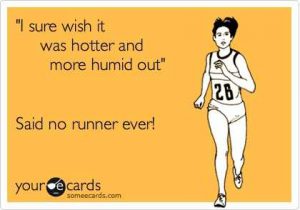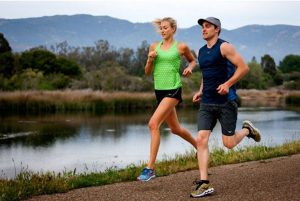Summer is a great time to run, but an increased body core temperature from heat, humidity, and dehydration resulting from increased sweating can inflict challenging hurdles. Adequate awareness, training, and precaution are important for acclimatization and full enjoyment of running. The key is to work with the heat rather than trying to beat it. In the long term your body becomes more efficient at cooling itself.
How does heat and humidity affect my body?

Running In Humidity
While running, body regulates the core-temperature by the process of sweat evaporation. The faster you run the higher your core temperature rises and higher the humidity, lower the evaporation of sweat, both could result in an imbalance of a body’s temperature regulation. This could lead to heat exhaustion which is characterized by rapid breathing, excessive sweating, and a fast or weak pulse; or to a more serious condition heatstroke where the body fails to regulate its own temperature and the body temperature reaches above 104 degrees. Heatstroke is a medical emergency; symptoms may include exhaustion, hot & dry skin, headaches, muscle cramps, confusion, nausea/vomiting, low blood pressure, palpitation, dizziness /fainting and could eventually lead to life-threatening situations.
Things that I can do:
- Check the outdoor heat and humidity levels from a weather forecast.
- Choose a run time based on weather pattern, early or late during the day.
- Gradual exercise–heat acclimatization (i.e., repeated training in the heat) ideally over two weeks, is essential for your body to improve exercise capacity in the heat. This is crucial for athletes preparing for competitions in warm–hot environments.
- Ensure a slow pace running to limit rise in core body temperature on a hot humid day.
- Wear protective eyewear and use broad spectrum sunscreens and visors/hats to battle UVA and UVB rays.
- Choose loose-fitting and sweat-absorbing garments. Synthetic materials and mesh insets can aid better moisture evaporation.
- Stop running if you experience very high/low pulse or breathing rate, hot dry skin, dizziness, or disorientation, and seek immediate medical help if symptoms continue.
- Consider cooling methods like ingestion of cold fluids or ice slurry or external methods like application of iced garments, towels, wetting skin/water immersion.
- Consider running on an indoor track or treadmill on extremely hot days.
Why hydration is important?
Dehydration increases the risk of heat exhaustion and heat stroke during and immediately after running. This is due to the rise in sweat rate (an average of 500- 2000ml per hour), which can lead to progressive dehydration if not minimized by increasing fluid consumption. A body fluid shortfall of more than 2% of your body weight marks dehydration that can negatively affect your performance. A stable day to day baseline first-morning post-voiding body weight and pale yellow urine can predict optimal hydrated status in most individuals. Although there are various factors that determine an individual’s fluid and electrolyte need, the minimum fluid replacement goal during most activities is to limit fluid deficits to less than 2% of baseline body weight. As sweat contains sodium we also need to replace extracellular sodium losses. An individual with an average sweat rate of one liter per hour can lose about 2-10g of table salt in a 2 hour practice. Sports drinks containing carbohydrates (sugar) and sodium (salt) can supplement sodium loss and aid better transfer of fluid to body cells than water.
Things that I can do:
- Check optimal hydration status by monitoring for a stable day to day baseline first-morning post-voiding body weight and pale yellow urine.
- Monitor pre- and post run body weight to measure dehydration.
- Carry fluids with you or plan for water sources during the run.
- To ensure proper hydration before training/competition in the heat, drink 6 mL of fluid per kg of your body weight every 2–3 hour.
- Replace your sweat losses or consume 5-10 ounces (150-300 ml) water every 15 to 20min when running less than 60minute, or 3-8 fluid ounces of a sports beverage (5-8 percent carbohydrate with electrolytes) every 15-20 minutes when exercising greater than 60 minutes.
- Space your ingestion of fluid for optimal re-hydration over a two hour period. A rapid ingestion of water or fluid may only stimulate increased urine production, thus less body water retention.
- Avoid excess consumption of pure water; this can lead to dilutional hyponatremia (drop in blood sodium level). Do not drink more than one quart/hour during exercise.
- Avoid alcohol, protein and caffeine (if you are not a habitual caffeine user) prior to running, they can modestly increase urine water losses.
- Recovery hydration regimens should also include sodium (salt), carbohydrates, and protein.
Am I fit to run?
Your perspective can make all the difference, recognize your limits, be flexible and adapt your run pace to fit your health and the weather conditions.
- Consult your doctor about running in the heat if you have heart or respiratory problems or you are on any medications.
- Following conditions may exacerbate heat illness: obesity, low degree of physical fitness, dehydration, lack of heat acclimatization, a previous history of heat stroke, sleep deprivation, certain medications (diuretics and antidepressants), and sweat gland dysfunction or presence of sunburn.
- Young children and teenagers are more susceptible to a high climatic heat stress. They are at a disadvantage of heating up easily due to their smaller body surface area which decreases evaporative heat loss for cooling.
- Be aware of symptoms of heat exhaustion and dehydration
- Run with a partner if you are a beginner or have health problems. Be responsible for the other’s safety.
Nejin Chacko PT, BPT, MSc (Medicine and Science in Sports and Exercises).
https://applecreeksportsmedicine.com/nejin-chacko-p-t/
Reference
- ACSM | Brochures. (n.d.). Retrieved June 18, 2017, from http://www.acsm.org/public-information/brochures
- Armstrong, L. E., Epstein, Y., Greenleaf, J. E., Haymes, E. M., Hubbard, R. W., Roberts, W. O., & Thompson, P. D. (1996). American College of Sports Medicine position stand. Heat and cold illnesses during distance running. Med Sci Sports Exerc, 28(12), i-x.
- Casa, D. J., Clarkson, P. M., & Roberts, W. O. (2005). American College of Sports Medicine roundtable on hydration and physical activity: consensus statements. Curr Sports Med Rep, 4(3), 115-127.
- Racinais, S., Alonso, J. M., Coutts, A. J., Flouris, A. D., Girard, O., Gonzalez-Alonso, J., . . . Periard, J. D. (2015). Consensus recommendations on training and competing in the heat. Br J Sports Med, 49(18), 1164-1173. doi:10.1136/bjsports-2015-094915

